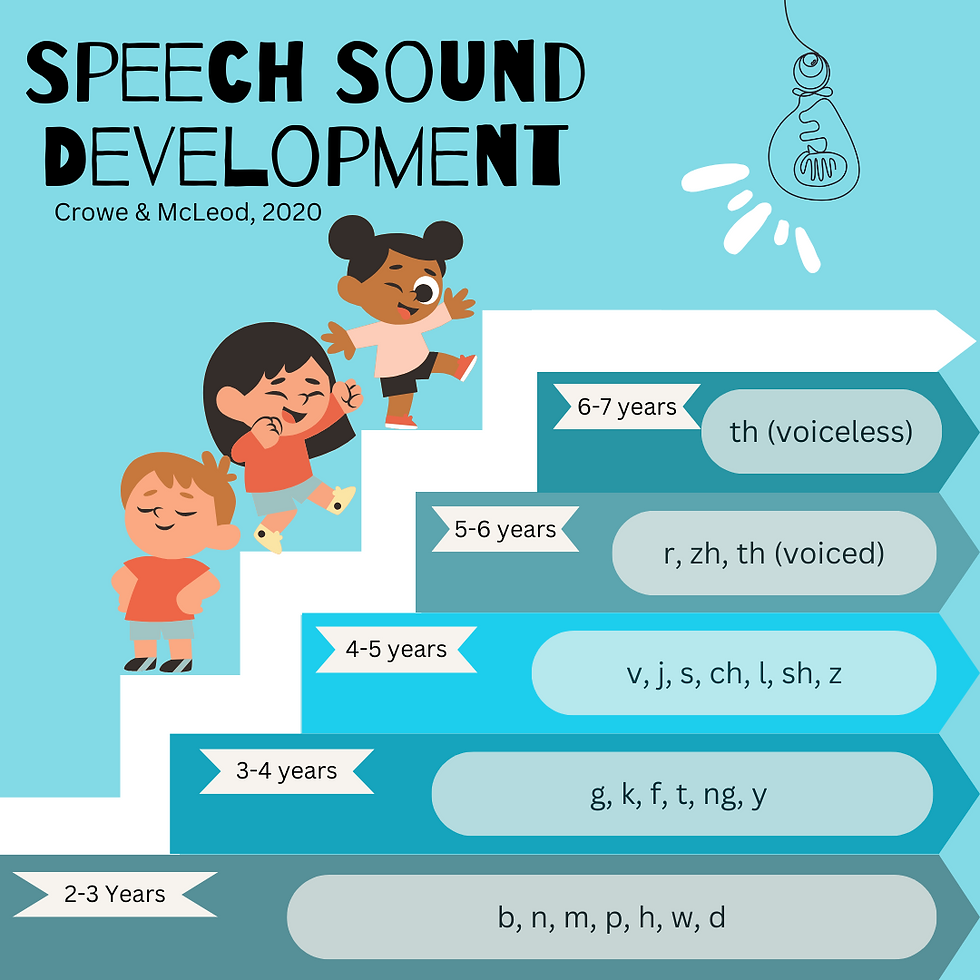Does my toddler need an SLP?
- Erin Swinkels
- Sep 15, 2023
- 4 min read
Often when we first meet a family who has concerns about their toddler's speech or language they've been told by another parent or their family doctor to connect with a speech language pathologist (SLP), but don't really know what to expect.

As a parent you have probably heard a lot about developmental milestones and answered a variety of yes or no questions at your child's well-checks. If you've ever had to say "no" to one of these questions (we have!) we know that this can lead to some stress, anxiety, and/or panic.
Here are three steps to ease that anxiety:
1) Understand what an SLPs role is and what to expect at an assessment
An SLP is a professional who understands the power and importance of communication and understands the typical developmental progression of speech and language development. Your SLP is going to consider a lot of different areas when getting to know your child and assessing their communication. We will look at hearing, receptive language, expressive language, articulation (speech), imitation, social skills, play skills etc...
First and foremost we will want to rule out any hearing concerns. You will likely be asked about whether there is a history of ear infections and you will be recommended to get your child's hearing assessed - even if they passed their infant hearing screening. For some kids there can be medical reasons for reduced hearing such as fluid in the ears (without an active infection) that may be impacting how much your child is hearing during the day.
Depending on your child's age, the first assessment or intake paperwork will likely include a lot of questions for the parents so the SLP can get a good sense of your child's general development and medical and family history, as well as get a sense of what your child's strengths are. The SLP will also likely engage or observe your child in a play based activity or setting that promotes free play, with the goal of creating lots of opportunities for speaking or participating across a variety of fun and interactive activities. Sometimes kids are shy or take a bit to open up so if you don't feel like the SLP got to see all of your child's skills it may be helpful to share videos with the SLP. If your child is old enough for formal assessments, the SLP may also engage your child in some specific tasks to get a measure of how your child does compared to other children their age.

2) Understand developmental checklists and what makes an effective communicator
Developmental checklists are a list of functional skills that most children perform around a certain age. When we say "no" on a developmental checklist we don't always see this as a clear cut "problem" that needs to be addressed. There are many factors that may influence whether a child not having a skill is reason to initiate early intervention services.
For example, there are cultural differences, and what is expected in one culture by 2 years of age (such as eating with utensils) may not be expected in another culture. Sometimes we also may consider the intent of the item rather than focus on the exact specifics. For example, at 15 months a common item on a checklist is that your child will look at pictures while you name them. What we really care about here is that your child engages in what's called joint attention (in this case looking at a common item) and attends to your auditory information (i.e., label) while an item is specified (e.g., cat vs. dog). Maybe they are even starting to be able to find an item on the page that you name. This is an important way that children contact vocabulary exposures in daily routines such as reading picture books. However, your child may only like listening to what things are called in pictures when they are the ones pointing, or your child may only have patience for this type of an activity when they are in a shopping cart and you are labelling items at the grocery store as you shop. Both of those alternatives still fit the intent of this item.
If you live in Ontario check out these free checklists available in 9 languages: https://lookseechecklist.com/en/
We would also argue that for toddlers sometimes what matters more than the nitty gritty details of each item on a developmental checklist are the pre-linguistic skills that your child has. In addition to these, there are a lot of other skills that make up a good, effective communicator that often come before a child starts vocally communicating their wants and needs. These include:
Persistence
Initiations
Effectively gaining their communication partner's attention
Able to communicate messages effectively
Able to repair communication breakdowns
If your child is demonstrating these skills but isn't yet using many words these are still skills to celebrate! Some kids (like ours) have that persistence piece down pat! Check out our post here for more details on each of these skills!
3) Understand the difference between receptive and expressive language
Receptive language is your child's understanding or comprehension of language. For example, being able to locate something (e.g., find your teddy), follow instructions (e.g., come sit at the table, put your shoes on, throw this in the garbage etc...) or understand questions (e.g., do you like _? are you ready to go? where's daddy?).
Expressive language is your child's ability to use their vocabulary to express themselves and communicate in a variety of ways. For example, being able to ask for things, express likes, dislikes or ideas, answer questions, comment on things in the environment etc...
Receptive language typically comes before expressive language, meaning your child learns what a word means before they begin to use it to communicate.




